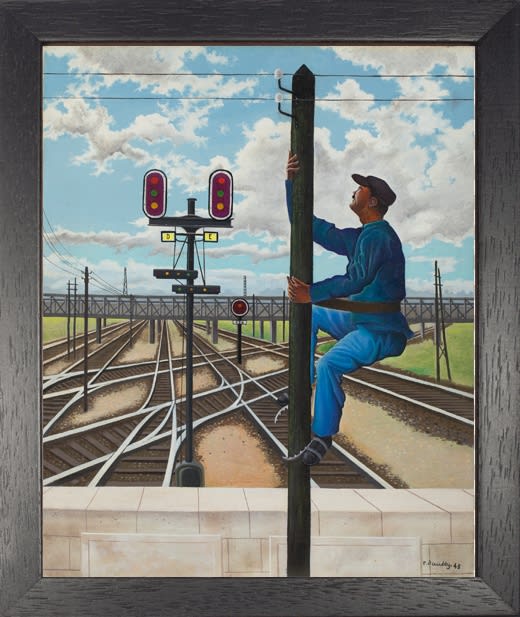

RAYMOND DAUSSY CHERBOURG 1918-CÉZABAT 2009
70 x 62 x 8 cm (with the frame)
An artist as interesting as his work is rare, Raymond Daussy trained at the Ecole des Beaux Arts in Rouen and pursued his studies in Paris, starting to show his work at the Salon d’Automne on a regular basis from 1941. In 1947, following World War II, Daussy became one of the founder members of the Surrealism-Revolutionary group of artists which formed in the wake of surrealist par excellence André Breton’s departure for the United States of America.
Daussy’s art oscillates between a strong attraction for realism and a fully-fledged aspiration to fantasy, tending towards a delicate and poetic form of daydreaming.
In his painting he expressed a personal take on reality while showing a particularly clear grasp of space. He was fascinated by the aesthetic of the Primitives such as Piero della Francesca and by the great masters of the Italian Renaissance, yet he showed no compunction in shaking off the traditional rules of perspective by breaking into the observer’s spatial focal points. Thus his paintings offer us snapshots that astonish us, capturing images in a precarious, suspended balance.
The suspended the moment becomes a crucial turning point, and it is at the precise moment when everything is in a state of flux that the artist begins to tell us his story.
Daussy’s art merges a particularly sophisticated handling of texture with a homogenous painterly style which uses a “script” all of its own, imbued with poetry and mystery. While his images remain anchored to scenes of daily life, they nevertheless succeed in laying bare his unique and unusual temperament.
To understand the gestation process of this interesting picture we need to go back to 1944, the year in which Daussy began to paint pictures in a style which one might call “antigravitational” and in which he continued to paint well into the early 1950s.
It was precisely in those years that the artist sought to detach himself from reality in an imaginative fashion, harmonising metaphysical apprehension and seeking to trigger an increasingly incisive sense of levitation and abstraction in the observer.
Fascinated by ephemeral movements such as Revolutionary Realism, Daussy illustrated his intuitive visions, which were firmly linked to a period in history that was witnessing immense change.
While his images remain anchored to scenes of daily life, they nevertheless succeed in laying bare his unique and unusual temperament.
“Devising a painting means enforcing the legitimacy of approximations held to be inadequate. The painter’s art consists in modulating that discrepancy in such a way as to produce an intelligent solution capable of resolving that situation.”
- Raymond Daussy


